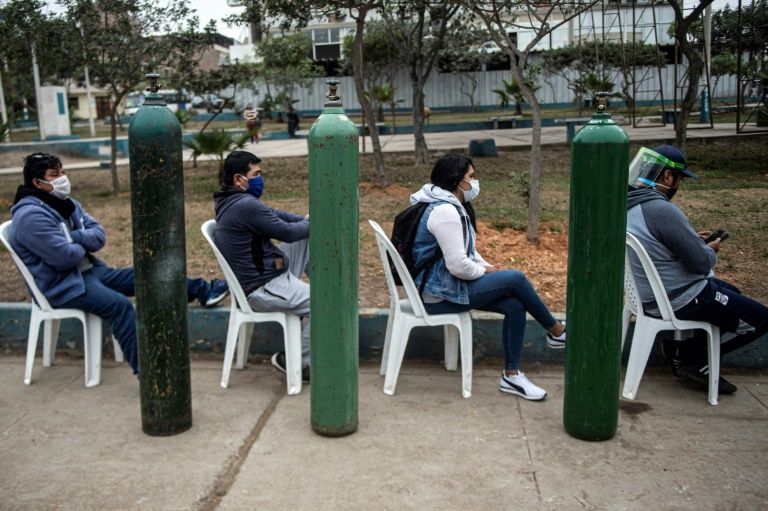Coronavirus deaths top 150,000 in worst-hit US
Relatives of COVID-19 patients queue to recharge oxygen cylinders in Peru, which has now passed 400,000 confirmed coronavirus cases. ©AFP Ernesto BENAVIDES
Washington (AFP) – Southern and western regions of the United States were grappling Thursday with a renewed surge of coronavirus infections as the death toll in the world’s worst-affected nation passed 150,000.
Brazil is second to the US in terms of cases and fatalities, and also reported a sobering figure as it surpassed 90,000 deaths.
Exactly six months after the World Health Organization declared an international emergency over the deadly pathogen, countries around the globe are seeing rises in infections that are damaging economies and forcing disruptive protection measures.
Even nations that believed they had largely curbed the disease are being gripped by worrying second and third-wave resurgences, with Australia on Thursday reporting a record number of new infections and its deadliest day of the pandemic so far.
Despite efforts in place to contain the virus, COVID-19 has killed more than 666,000 people around the world and total infections have passed 17 million, according to an AFP tally.
Global daily cases are now approaching the 300,000 mark, with the curve showing no sign of flattening — it took just 100 hours for one million new cases to be recorded.
– Surge in Australia –
Days after Australian authorities expressed hope that a Melbourne lockdown — now in its third week — was bringing persistent outbreaks under control, the surge is a potent warning that initial successes in managing COVID-19 can quickly unravel.
Thirteen deaths and 723 positive tests were reported in the southeastern state of Victoria alone, well beyond the previous nationwide record of 549 cases set on Monday.
Prime Minister Scott Morrison said the steep rise in numbers was “very concerning”.
In Hong Kong, where authorities fear a worrying third-wave of infections could cripple the healthcare system, the government reversed a day-old ban on restaurants serving dine-in customers following widespread public anger.
All restaurants in the city of 7.5 million were ordered to only serve takeaways as part of a raft of ramped-up social distancing measures aimed at combating the fresh wave of virus cases.
But social media was quickly swamped by photos of primarily blue-collar workers forced to eat on pavements and in parks — and even inside public toilets to escape a torrential downpour.
The United States, however, is still battling its first wave, having never taken control of the virus, and on Wednesday alone the country recorded 1,267 new deaths in the past 24 hours and notched more than 68,000 new daily cases.
Southern and western states have been particularly hard-hit — especially Florida, where more than 6,300 people have died.
– EU travel list –
The EU is due Thursday to update its list of countries approved for travel to the European bloc, which it reviews every two weeks. The United States was not on the list and is not expected to be included.
The EU’s safe list does, however, include Australia, Canada, Georgia, Japan, Morocco, New Zealand, Rwanda, South Korea, Thailand, Tunisia and Uruguay.
The bloc is expected to announce that Algeria is being removed from the list after a resurgence of coronavirus.
Meanwhile several countries in Europe have slapped restrictions on travel to and from Spain, while officials elsewhere bicker over the seriousness of the current outbreak.
UK Prime Minister Boris Johnson, fresh from announcing quarantine for travelers returning from Spain, suggested the rest of Europe could be facing a second wave — despite his own country’s dismal figures.
France’s health minister hit back on Wednesday, saying his country was categorically not in a second wave.
Spain, one of the countries hit hardest by the pandemic, insists it is a safe destination and was critical of Britain’s blanket quarantine, which includes islands without significant outbreaks.
Brazil also wants visitors back, and on Wednesday reopened travel to foreigners arriving by plane, hoping to revive its lockdown-devastated tourism industry. The country closed its air borders to non-residents on March 30, at a time when the virus was just taking hold in South America.
Neighboring Peru on Wednesday passed 400,000 confirmed coronavirus cases, the health ministry said, after the largest daily increase in infections for more than six weeks.
Nearly 19,000 people have died as a result of the disease nationwide, and the country has recorded more COVID-19 cases than anywhere in Latin America except for Brazil and Mexico.
burs-je/rma
Disclaimer: Validity of the above story is for 7 Days from original date of publishing. Source: AFP.


